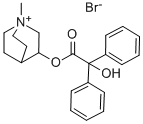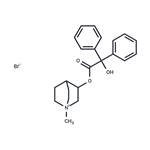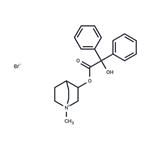
Clidinium bromide
- Product NameClidinium bromide
- CAS3485-62-9
- MFC22H26BrNO3
- MW432.35
- EINECS222-471-3
- MOL File3485-62-9.mol
Chemical Properties
| Melting point | 240-241°C |
| storage temp. | Inert atmosphere,Room Temperature |
| solubility | DMSO (Slightly), Methanol (Slightly, Sonicated), Water (Slightly) |
| form | Solid |
| color | White to Off-White |
| CAS DataBase Reference | 3485-62-9(CAS DataBase Reference) |
Safety Information
| Hazard Codes | Xn |
| Risk Statements | 22 |
| Safety Statements | 36 |
| RIDADR | 3249 |
| WGK Germany | 3 |
| RTECS | VD6125000 |
| HazardClass | 6.1(b) |
| PackingGroup | III |
| HS Code | 2933399090 |



